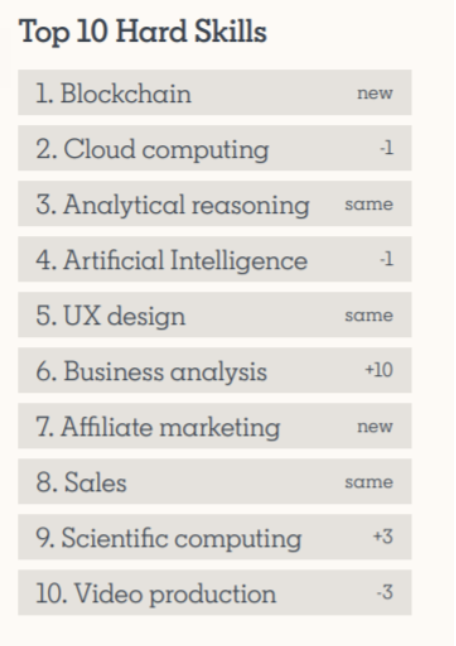In a 2020 workplace learning report, LinkedIn revealed that one of the most in-demand jobs skills for 2020 is affiliate marketing, reinforcing the importance of affiliate partnerships.

Every year, LinkedIn produces a list of in-demand skills that organizations need to consider in developing their learning and development programs. The list is also helpful to aspiring marketers keen to future-proof their careers. Affiliate marketing is one of the two “new” hard skills to make the list this year (see the chart).
Is the new ranking just indicative of the job market? Or should affiliate marketing be a top priority for enterprises wanting to stay afloat or even increase revenue during trying times? In this blog, let’s explore:
- The impact of recent events on affiliate marketing
- Why affiliate marketing is a top in-demand skill for 2020
- How organizations can leverage the opportunity to grow affiliate partnerships
- How to gain consumer trust at a time when there’s little to be had
Why affiliate marketing? Why now?
On the back of unprecedented global unrest and with COVID-19 front and center, consumers are understandably overwhelmed. Trust in what we see is at a low point and, as a consequence, traditional advertising and brand-driven social media ads are not doing well. In fact, a recent Kantar’s Dimension study reveals that amid the global crisis there’s overall consumer mistrust toward both advertisers and social media platforms, with just 14% of consumers saying they trust advertisers. Global media investment is also predicted to drop by a quarter by H1 2020, and 57% of organizations in the United States have already introduced cuts to annual marketing budgets.
Consumer behavior has changed, too
The EY Future Consumer Index recently tracked consumer behavior and sentiment across five markets. The report discovered that 42% of consumers believe the way they shop will fundamentally change as a result of the pandemic, including where they shop and what products they will spend money on:
- 34% would pay more for local products
- 25% will purchase only from trusted brands
- 23% for ethical products
As more of us must stay at home or work from home, it’s no wonder our online habits have changed. More importantly, our distrust for direct advertising or brand social ads has grown. We recently provided some performance benchmarks on what this means for partnerships programs, including:
- Clicks were initially higher in April but began to decline in May
- Conversions were initially high in April but are now lower than average
- Revenues and commissions went up in April then significantly dipped
Consumer trust just got even lower
It’s hardly news that consumers are losing trust in traditional advertising, with consumer trust already at an all-time low of just 25% in December 2018 (a sharp decline from 48% in 1992). It’s no wonder that a pandemic and general civil unrest have caused further declines. To rebuild consumer trust during times of rapid change, enterprises must adapt to survive. In a recent article in The Drum on consumer trust issues, Mark Inskip, Chief Executive at Kantar UK and Ireland’s Media Division, explained:
“The advertising and media industries rely on one another to survive, so during trying times, it’s imperative to ensure consumers receive accurate and relevant content, in an appropriate context across all platforms.… If authenticity, transparency, and consistency are properly maintained, consumer trust can be rebuilt.”
With everyone now online even more (and with 4.57 billion now using the internet — up 7% since this time last year), we are also getting more savvy about curating the content and channels we use and engage with online. One study discovered that one in three consumers have already “punished” brands that responded badly to recent events. Unsurprisingly, enterprises dealing with internal pressure to adapt are being forced to reevaluate the best way to reach consumers, both in terms of maintaining loyalty and gaining acquisition.
Does affiliate marketing live up to the hype?
Well, we’ve said it before and we’ll say it again, in the traditional sense affiliate marketing is dead and interest in the search term “affiliate marketing” has steadily declined in the last 5 years for good reason. In order to stay ahead of the game in 2020, taking a more collaborative, authentic, and diverse approach to affiliates is king, and therefore, by translation – affiliate partnership is THE top skill for 2020.
What makes affiliate partnerships so special?
It’s important to think bigger than affiliate marketing, which is why it’s important to think of affiliates as partners. Think about it, the performance-based affiliate model can be applied to just about any kind of partnership, including influencers, strategic B2B corporate partners, and mobile apps. “Affiliate” is really just a framework for high ROAS performance marketing. The affiliate marketing industry has evolved and expanded beyond the practice of traditional affiliate marketing methods in recent years, so it makes sense to follow that evolution with the evolved term “affiliate partnerships.” Building stronger and more authentic relationships with affiliates can now deliver:
- Greater brand loyalty and retention of high-performing partners
- Improved performance across your entire partner network, not just the top few
- Increased engagement with affiliates through custom communication
- Increased revenue from a wider portfolio of partners using customized payment models and rewards
- Greater content quality and brand alignment through improved communication
Affiliate partnerships are more likely to garner consumer trust
Pushing brand messages to consumers has been an ineffective approach for a long time, and even more so now. If you nurture relationships with authentic affiliate partners that have already built trust with your target demographic, you, too, will garner more trust. Millennials in particular are 247% more likely to be influenced by blogs or social networking sites. Put simply, if someone hears about your product from someone they trust, they’re already more likely to trust that your product is worth buying. Not only true of affiliate partnerships, this same value can be found in influencer partnerships, with 49% of consumers depending on influencer recommendations and 40% purchasing after seeing a product on Twitter, Instagram, or YouTube.
2020 challenges: It’s not all rainbows and unicorns
It’s great news that affiliate marketing has been validated as a high-priority skill for 2020 and has consequently reinforced the value of affiliate partnerships. However, it’s important to address the impact of current events on the industry, which has not been without its challenges. Most notably, the economic impact of the pandemic has led to consumers being more careful with spending. Affiliate marketers are also dealing with reduced commission rates across networks.
To navigate the current climate, it’s worth reflecting on the mindshift consumers experienced during the recession of 2008, which led to a rise in coupons, discounts, and loyalty programs. As the COVID-19 pandemic continues to unfold, forces have collided. Organizations are looking for ways to increase revenue and motivate housebound consumers to buy. They’re also trying to cut costs and manage internal pressure on employee health and well-being. It’s a lot to unpack, but the good news is that affiliate partnerships offer solutions for both a cost-effective performance-based business model and the ability to incentivize buying with deals and loyalty perks.
Why affiliate partnerships can help you weather the storm
In times of crisis, enterprises need to secure their revenue, but they also need to nurture affiliate partnerships. To do so effectively, it’s critical to invest in partnership technology that enables you to drive revenue on a pay-on-performance basis. From there, you’ll discover low-risk and measurable ROI-elevated affiliate partnerships without undercutting affiliates at a time when they need you most. In a recent podcast on the subject of managing partnerships amid COVID-19, Impact CMO Scott Brazina reinforced the point that organizations with a mature perspective on partnerships are the ones still generating revenue in the current climate:
“Last year, a global Forrester study showed that partnership-mature companies were generating upwards of 28% of total company revenue through partnerships, and growing it an average of 28% compared to the laggards. Compared to partnership-mature companies, partnership-immature companies tended to be at around 18% revenue. The point is, companies dedicated to their partnership programs are seeing real success in the marketplace.”
If you’ve previously held back on scaling up your affiliate program or been reluctant to transition from traditional affiliate marketing tactics to affiliate partnerships, now is the time to strike. As cofounder of Impact, Todd Crawford, put it in a recent article:
“Enterprises that double down on their partnership programs and forge new partnerships with subject matter experts, affiliates, influencers, and other media sources that consumers trust are likely to weather this period of economic uncertainty better than their peers.”
Now’s the time to nurture affiliate partnerships
Many marketing tactics and traditional approaches are long out of date, but partnerships will always be valuable. That’s why affiliate marketing made it to LinkedIn’s top 10 list of in-demand skills for 2020.
Whether you’re already running an affiliate program and looking for guidance or considering taking your first step into the realm, here are five ways you can leverage partnership opportunities as an organization:
- Arm your employees with affiliate marketing skills or hire experienced affiliate marketers
- Shift budgets from traditional advertising toward affiliate marketing
- Invest in partnership automation and affiliate marketing technology
- Focus on loyalty and open communication with existing partners
- Don’t exploit partners or potential affiliates; support them and pay fairly
Every organization is part of the partnership economy because partnerships have been around for centuries. To treat your affiliates like anything other than partners, especially now, just doesn’t make sense.
For more tips on how to leverage partnerships and weather the storm in the current climate, check out Navigating partnerships in a crisis or contact a growth technologist at grow@impact.com.




